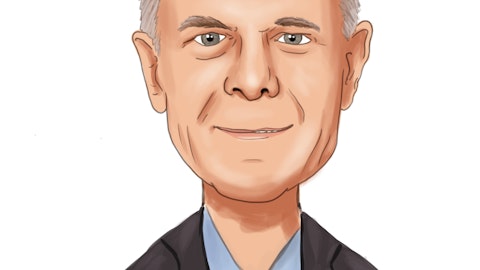Gary Kramer: Yeah. I would say it’s predominantly client-driven as we think of our enhancements to myBBSI, it’s really think of that client first and think about the employee life cycle that they have with their employees. And then how do we feel that employee life cycle data, number one? And then number two, how do we push and pull data via APIs and things like that with other sources. So that’s kind of the focus of, think of the client first as far as specifics. I don’t want to give specifics until we actually launch products, and we’re going to have products that we’re launching later in the year.
Jeff Martin: Okay. And then last one for me, if I could. On the adjustments to prior year workers’ compensation liability and premiums, $13 million last year, roughly $15 million this year. I assume that’s going to tail off at some point. How should we think about that for maybe 2024 and 2025 in terms of a potential range? I know it’s hard for you to predict. But just in terms of how to think — how people should think about it from a modeling standpoint?
Gary Kramer: We’re conservative by nature when we set our current year loss rates. And then — sorry, this is — I’m going to give you a Kramer answer. I’m going to wander on this one, Jeff. So we have what I call best-in-class structural partners. We’ve got best-in-class risk managers, underwritings, claims folks, operation, actuarial. We are a very mature organization. We have tech, we have AI that we adopt to help us with all of this. And then we have about 200 folks either directly or indirectly that work on workers’ comp at our organization. We structured these new programs so that the interest is aligned with the market. If things are favorable, the market makes money and then we, as BBSI and as shareholders get money back.
We did that because we thought this would be more attractive to investors because it’s a derisked model. And we thought that we would get multiple expansion with them. Our conservatism in our results, you have to fact check me on this, but I think we’ve had 20-plus quarters, Anthony? 20. 20 quarters of favorable changes in estimate for prior year liabilities and for premium adjustments. 2024 was our largest in our history. So if you just look at the trend, the trend for that aspect is our friend, right? So we feel like we’ve set ourselves up that this trend is going to continue. And if you look at ’23. That was the largest number we’ve had in our history.
Jeff Martin: Helpful. Thank you.
Operator: [Operator Instructions] Our next question is from the line of Vincent Colicchio with Barrington Research. Please go ahead.
Vincent Colicchio: Good afternoon, Gary. Curious how your view of the economy has changed since last quarter? I assume it’s a bit better, if I heard correctly, you’re assuming that existing clients will hire, people will expand their roles in ’24.
Gary Kramer: Yeah. If you just think about, call it, our last 18 months of experience, right, from just the payroll exposure, we started to see our clients pull back at Q4 of ’22, and they pulled back in Q1 of ’23, pulled back some in Q2. The nice thing was in Q3 of ’23 was when we started to see it stabilize, slight hiring. In ’24, for Q4 of ’23, we saw slight hiring as well, right? So we’re seeing stability in Q3. We see stability in Q4. And then the numbers that we’re seeing so far through January and February is more stability. So we — when we look at the business that reduced their workforce, that was primarily in the construction and trades. And if you look at the construction trades, you just look at the housing starts, things are coming back now, and that’s what gives us kind of more optimism for our workforce that our clients are going to resume hiring into ’24.
Vincent Colicchio: And if you double your healthcare clients by next year, the amount of income that comes in from that, is that what you would have — let me ask — what I’m trying to say is, will that be a meaningful amount of income to the company if you hit that goal?
Gary Kramer: We’re not going to guide to just the product line, but we’re not doing this for pennies. We’re doing it for dollars.
Vincent Colicchio: Okay. And then you said you have 15 asset-light programs in place currently. Curious if some of those have already converted to physical locations and how do you feel about opening additional physical locations this year?
Gary Kramer: Yeah. We are in a couple of the markets we’re actively searching for real estate, and we are also recruiting to have local support. So in a couple of the markets, we’re looking at local HR because we’re doing pretty well in those spots. We anticipate that we’ll probably have 3 markets that go brick-and-mortar in ’24 and then more of that to follow in ’25.
Vincent Colicchio: Thanks, Gary. I’ll go back in the queue. Nice quarter.
Gary Kramer: Thank you.
Operator: Thank you. Our next question is from the line of Marc Riddick with Sidoti & Company. Please go ahead.
Marc Riddick: Good evening everybody. So I was wondering if — with this being the first selling season for first key selling season for BBSI, if you could talk a little bit about the benefits, I’m sorry, for the — were there any particular learnings or things that have taken place as you’ve gone through this process thus far that have been slight positive surprise, slight negative? Anything as part of that process that was outside of expectations?
Gary Kramer: I’d say I’m glad I lost my hair prior to this rollout. It was not a straight line. It was — we learned a lot of things along the way. Part of what we’re doing right now is while it’s still fresh, we are having a whole continuous improvement team to go through and understand what do we need to do better on the sales service underwriting for new and renewal. We — I could say I’m proud of the team, I’m proud of the company, I’m proud of the organization for getting it done. We learned a lot of lessons, but probably good lessons that we can build upon.



